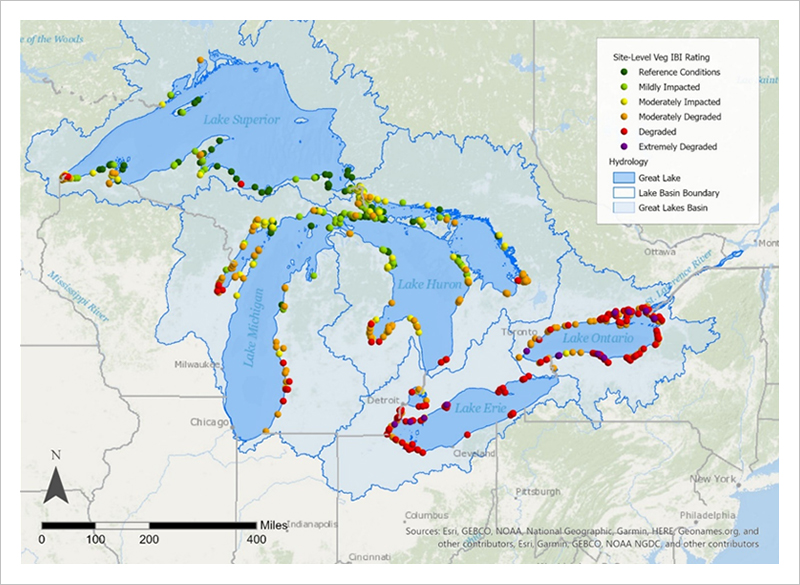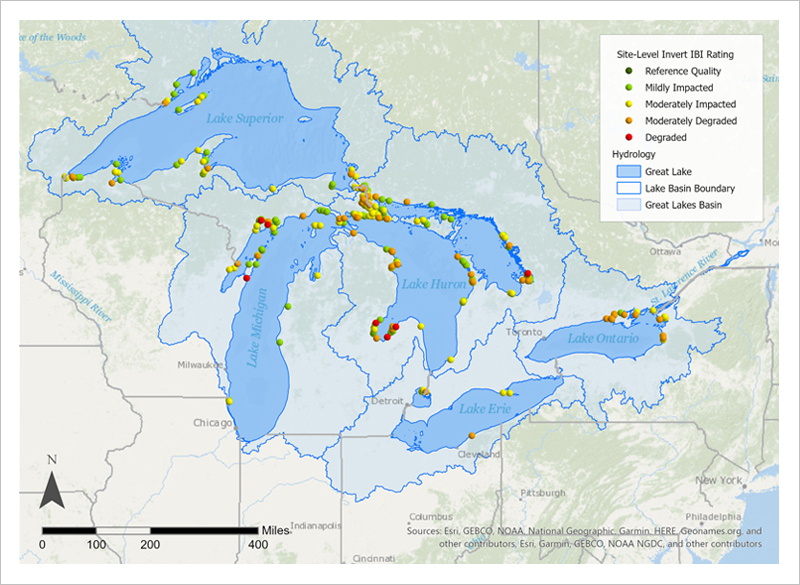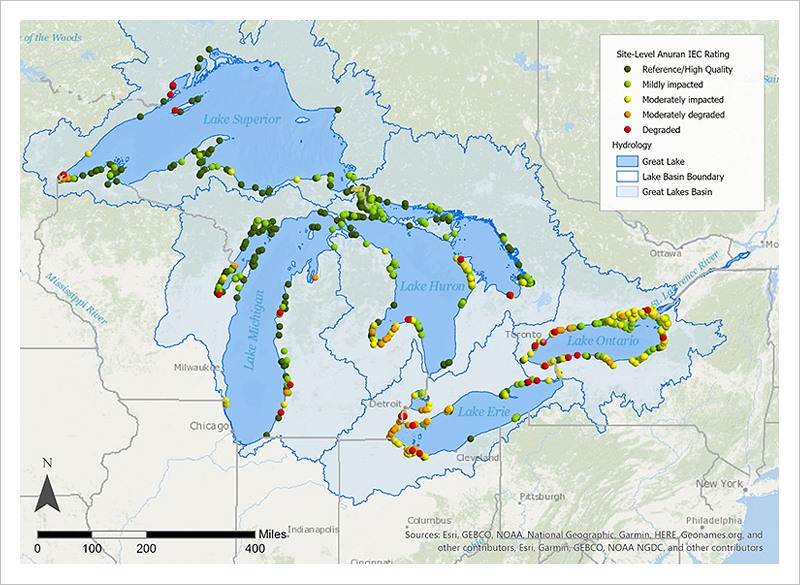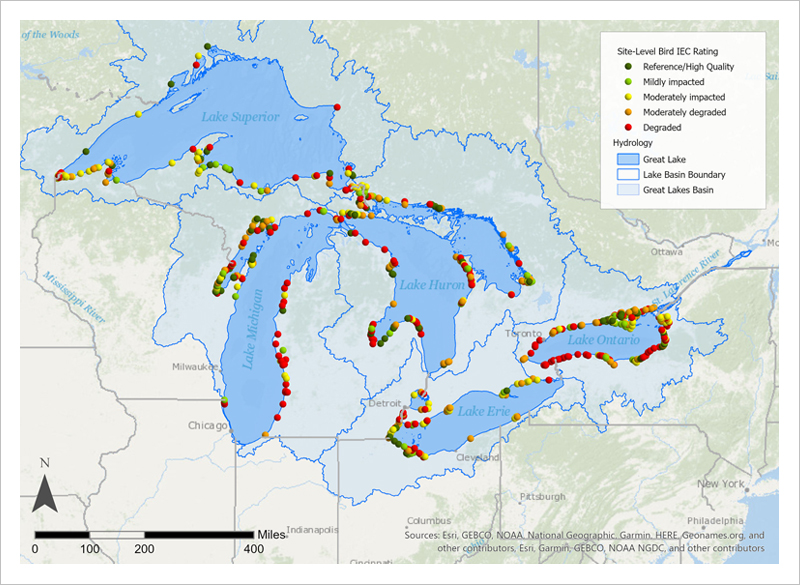Great Lakes CWMP Results and Major Findings
The Coastal Wetland Monitoring Program (CWMP) collects critical data needed to assess the health of Great Lakes coastal wetlands. The program conducts surveys to collect data on plant and animal communities, water quality and site characteristics within each coastal wetland monitored. This page describes plant and animal community health in Great Lakes coastal wetlands based on data and results from 2011-2018. The CWMP visited approximately 200 coastal wetlands each year during this timeframe. Further information about coastal wetland health can be found in the triennial State of the Great Lakes Reports.
On This Page:
- Plant (Vegetation) Community Health
- Macroinvertebrate Community Health
- Fish Community Health
- Amphibian (Anuran) Community Health
- Bird Community Health
Plant (Vegetation) Community Health
The number and abundance of species in a plant community changes over time in response to both natural and human-caused disturbances. The CWMP monitors the wetland plant community in up to 3 different vegetation zones (wet meadow, emergent and submerged aquatic vegetation) at each sampling site, depending on which zones are present. Different vegetation zones create different habitats for wildlife communities, such as fish, macroinvertebrate, bird and amphibian communities, that also are monitored by the CWMP.
The CWMP uses a vegetation Index of Biotic Integrity (IBI) to assess plant community health in monitored coastal wetlands. Vegetation IBI results from 2011-2018 demonstrate that Lakes Superior, Michigan and Huron tend to have less degraded wetland vegetation (higher IBI scores) than wetlands in Lakes Erie and Ontario (Figure 1). More degraded plant communities in Lakes Erie and Ontario are due to greater amounts of human disturbance, nutrient runoff and invasive species as compared to the other lakes. The CWMP also provides important information about the presence and abundance of invasive plants such as invasive cattails (Typha angustifolia) and Phragmites. These data are important in planning restoration projects and evaluating their success.

Macroinvertebrate Community Health
Freshwater macroinvertebrates are a diverse group of organisms that are small yet visible to the naked eye and inhabit freshwater aquatic environments such as wetlands, lakes and streams at some point during their life cycle. Macroinvertebrates play a critical role in coastal wetland food webs serving as an important food source for many organisms, including fish, amphibians, birds and mammals.
The CWMP monitors the wetland macroinvertebrate community in different vegetation zones at each site using D-frame dip nets. Samples are preserved and the macroinvertebrate species are identified and recorded. The CWMP uses a macroinvertebrate IBI to evaluate macroinvertebrate community health in monitored coastal wetlands. Macroinvertebrate IBI results from 2011-2018 show that each of the Great Lakes have wetlands with healthy macroinvertebrate communities and degraded communities (Figure 2). Macroinvertebrate data are less available in Lakes Erie and Ontario because wetlands in these lakes are commonly dominated by invasive plants and do not have the vegetation zones (wet meadow, emergent and submerged aquatic vegetation) where macroinvertebrates must be collected for IBI calculations.

Fish Community Health
More than 80 species of fish, including game fish and those important for commercial fisheries, rely on coastal wetlands at some point in their life cycle. These fish species rely on specific coastal habitats for feeding, spawning or protection while fish larvae develop into juveniles (nursery habitat). Coastal wetlands across the Great Lakes Basin vary seasonally and spatially in the diversity of fish species present. The presence of emergent and submerged aquatic vegetation, substrate type, water clarity, water temperature, pH and level of dissolved oxygen in the water column influence the type of fish species present and their abundance in a coastal wetland.
The CWMP monitors the wetland fish community at each site by deploying nets in different vegetation zones overnight. Captured fish are identified and measured. Fish survey data are used to compute a fish IBI, which is an indicator of fish community health. Each of the Great Lakes have wetlands with healthy fish communities as well as wetlands with degraded fish communities based on the fish IBI (Figure 3). The CWMP provides important information about the presence and abundance of non-native and invasive fish species. Non-native and invasive fish are found in all the Great Lakes and connecting rivers, but Lake Erie wetlands tend to have more invasive fish species than wetlands in the other lakes. Larger numbers of non-native fish species can reflect reduced ecosystem health. This information is helpful for resource managers.

Amphibian (Anuran) Community Health
Coastal wetlands are a key habitat for frogs and toads (referred to collectively as anurans). Thirteen species of frogs and two species of toads are known to inhabit coastal wetlands across the Great Lakes Basin. To date, the CWMP has not documented the presence of any non-native frogs or toads at monitored sites. Anurans play an important role in the Great Lakes coastal wetland food web as anuran eggs, tadpoles and adults provide food for fish, reptiles and birds.
The CWMP monitors the wetland anuran community at each site by visiting one or more locations at night during the breeding season and listening for the distinct calls of the different frog and toad species. Anuran survey data are used to calculate an anuran Index of Ecological Condition (IEC) score. Data from 2011-2018 show that wetlands in Lakes Superior, Michigan and Huron tend to have less degraded anuran communities (higher anuran IEC scores) than wetlands in Lakes Erie and Ontario, but that a range of conditions can be found in each lake (Figure 4). In addition to providing information about wetland health, CWMP anuran data provide important information about the presence and abundance of threatened anuran species as well as species of special concern.

Bird Community Health
The Great Lakes coastal wetlands represent critical habitat for over 340 breeding, resident and migratory bird species that depend upon these important ecosystems for food, shelter, raising young or as migratory rest stops. Water quality, plant community and adjacent land use all influence bird community composition and health in Great Lakes coastal wetlands.
Data from CWMP bird surveys are used to calculate a bird IEC, which is an indicator of wetland health. Bird IEC scores from 2011-2018 show that each of the Great Lakes has wetlands with healthy bird communities and wetlands with degraded communities (Figure 5). Wetlands with degraded bird communities often have degraded plant communities. CWMP bird data are useful for identifying wetlands that need habitat restoration and for tracking the presence and abundance of endangered and threatened birds in the Great Lakes Basin. Some bird species, such as those that are wetland specialists or those that instinctively return to the wetland where they were hatched, are particularly vulnerable to habitat degradation and wetland loss. Because of this, CWMP data also are useful in wetland protection efforts.

Back to: About the Great Lakes Coastal Wetland Monitoring Program
